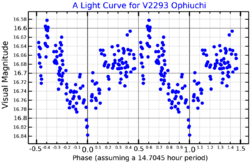Astronomy:GRO J1719-24
From HandWiki
Short description: Star in the constellation Ophiuchus
{{starbox observe| ra= 17h 19m 37s | dec=−25° 01′ 03″{{citation needed|date=April 2017}  A visual band light curve showing superhumps of V2293 Ophiuchi, adapted from Masetti et al. (1996)[1] | |
| Database references | |
|---|---|
| SIMBAD | data |
GRO J1719-24 (GRS 1716-249, V2293 Oph, X-Ray Nova Ophiuchi 1993) is believed to be a low-mass X-ray binary.[2] Its name derives from an X-ray transient, detected in 1993.[3] The system consists of a black hole candidate and a low mass companion, estimated to be a main sequence star of the spectral type K0-5 V.[4]
The rotation period is uncertain, estimated at 14.7h.[1] The light curve possibly exhibits some faster fluctuations as well, which are hypothesized to be produced by blobs of matter in the accretion disk.[1]
References
- ↑ 1.0 1.1 1.2 Masetti, N.; Bianchini, A.; Bonibaker, J.; della Valle, M.; Vio, R. (October 1996). "The superhump phenomenon in GRS 1716-249 (=X-Ray Nova Ophiuchi 1993)". Astronomy and Astrophysics 314: 123–130. Bibcode: 1996A&A...314..123M. https://ui.adsabs.harvard.edu/abs/1996A&A...314..123M. Retrieved 5 February 2022.
- ↑ Della Valle, M.; Mirabel, I.F.; Rodriguez, L.F. (1994), "The optical and radio counterpart of the X-ray Nova Ophiuchi 1993", Astronomy and Astrophysics 290: 803, Bibcode: 1994A&A...290..803D
- ↑ Ballet, J.; Denis, M.; Gilfanov, M.; R., Sunyaev (1993), IAU Circ., 5874
- ↑ Chaty, S.; Mirabel, I. F.; Goldoni, P.; Mereghetti, S.; Duc, P.-A.; Martí, J.; Mignani, R. P. (2002), "Near-infrared observations of Galactic black hole candidates", MNRAS 331 (4): 1065–1071, doi:10.1046/j.1365-8711.2002.05267.x, Bibcode: 2002MNRAS.331.1065C
 |

